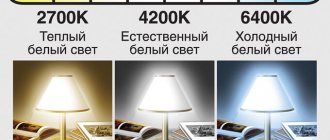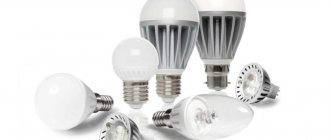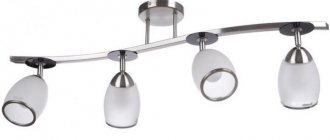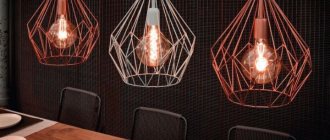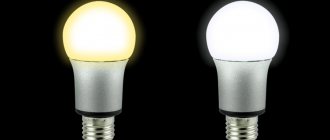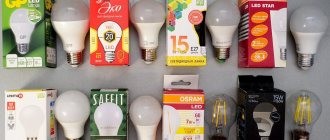Technologies are constantly improving and developing, and more effective solutions are emerging. The same applies to equipment that makes life easier: it is adjusted and supplemented with new functions. Modern lighting devices are significantly different from those of a few years ago. Standard incandescent lamps have been replaced by much more economical, practical and ergonomic 12 Volt LED lamps.
The products have many minor flaws, but constant development and research will ultimately lead to them displacing less effective analogues from the market.
Design
The design of lamps powered by a constant voltage of 12 V differs significantly from traditional incandescent or fluorescent lamps.
We list the main structural elements:
- Glass flask. Usually made from transparent glass (less often frosted) in the shape of a ball or disk. The dome shape allows you to significantly increase the dispersion angle, which reaches 270 degrees. Flat bulbs are used in point light sources for additional lighting. Some devices are used to illuminate interior items, others - for zoning spacious rooms. Spotlights have a minimal dispersion angle - from 30 to 60 degrees.
- LEDs are light sources. They are connected in series with each other, which allows to increase the luminous efficiency of the device.
- A radiator is an aluminum plate that removes heat that is generated during the emission of LED diodes.
- The case is made of durable plastic - it is an excellent dielectric and performs protective functions. Prevents electric shock during installation and removal of the device.
- Driver - stabilizes the voltage by converting alternating current to direct current at 12 V.
- Base. Due to the high popularity of the products, diode lamps are produced with a variety of bases. You can easily find standard products chambered for E27, E14, G4 cartridges. G13, GU10, etc.
The brightness of such a light bulb depends on the number of LEDs and the power of each of them individually. The illumination of products is calculated according to the ratio of 1 lm for every 100 W.
What LEDs can be connected to 12 Volts
Sellers claim that they sell LEDs that can be connected to a 12V power source. In fact, this statement is not true. An ice lamp does not have a strictly defined operating voltage, so we can only talk about a light source consisting of diodes.
it is necessary to determine what happens in the ice bulb during the glow. There are 2 most important parameters in this process: maximum and operating current (necessary for an incandescent lamp). They are taken into account when making the ice matrix, but not when choosing a power source.
The voltage on the light bulb is most often from 1.5 to 3.5 volts, the figure depends on the color of the light bulb. The lower the red LED value, the higher the brightness. A 12-volt luminous diode is a matrix (assembly) that can include any number of crystals connected in series. There can be several such chains; they are connected to each other in parallel.
Important! If someone says a lamp is rated at 12 volts, what they really mean is that the string of diodes in series draws 12 volts when turned on.
Varieties
Based on the power source, light bulbs are divided into two main categories - low-voltage, designed for operation on a 12 V network, and conventional, connected to a 220 V network. There are other varieties - 24, 36 or 48 V, which belong to the category of low-voltage LED lamps. Low-voltage ones differ from regular ones in the use of a driver (aka power supply) that stabilizes the voltage. It can be built into the product design by default or installed separately as an independent element.
The power of such sources is usually low and is in the range of 0.4–8.0 W. Moreover, fractional power values are used more often than whole ones.
Another criterion for classifying 12-volt LED devices is the shape of the glass bulb. The following varieties are distinguished:
- open type;
- devices with flasks of various geometric shapes;
- round flat products similar to a disk.
The most common are SMD type lamps. The brightness of the light flux is selected depending on the size of the product - the more LEDs, the more intense the lighting will be.
How to correctly connect a diode to a car's electrical circuit
The diagram for connecting LEDs to a 12-volt car battery is no different from the diagram for any other power source that has the same voltage. One of two methods is used: through a resistor or through a stabilizer (special chip). However, it must be taken into account that the voltage of 12 volts is a relative value. Most often it is 14 V and even more (up to 17 V). Jumps occur due to the lack of a stabilizer in the car. When calculating, you only need to enter these numbers in the formula.
When the resistor is turned on, some of the voltage is removed from the circuit, which can damage the LED. The main disadvantage of this circuit is the conversion of unclaimed current into heat. This requires installing a resistor on the heatsink, which creates additional complications. Also, the resistor does not control the voltage. When dropped, the lamp's glow decreases; if it increases significantly, the lamp may burn out.
When using a stabilizer, the chip also converts excess voltage into heat. The main advantage of this option is the ability to maintain a certain voltage level. This means that if it is necessary to connect several light bulbs, the total power of which is less than the power of the stabilizer, then a parallel connection is used. A radiator must also be connected to the chip.
Assembly sequence:
- find in the documents or measure the voltage of the LED light bulb(s);
- install an LED light bulb and a resistor on the radiators;
- find the polarity of the LED lamp legs;
- connect the battery.
- welding components;
- calculate and buy a resistor (driver);
- make a diagram;
It is recommended to measure the voltage and current in order to adjust the indicators in time.
If something is wrong, you will need to select a different LED.
Basic selection options
Incandescent lamps have many technical and operational characteristics. We list the main ones:
- Colorful temperature. Its value is in the range of 2700–6500 K. Depending on the specific value, the lamp may emit more cool (white) or warm (yellow) light when illuminated.
- Light flow. This parameter for LED products is usually high and reaches 600 Lm.
- Durability - the average lifespan of lighting fixtures is 50,000 hours.
- Power - from 0.4 to 8 W.
- Availability of driver. In fact, devices operating exclusively from a 12 or 220 V network are rare. Most often, manufacturers produce LED lamps with a wide voltage range - for example, 150–250 V. This means that such devices are not afraid of any serious voltage drops.
- Dimensions. This equipment is often used to replace halogen lamps, so manufacturers strive to simplify the installation process of the product as much as possible and provide more freedom by reducing its dimensions.
- Number of LEDs.
The product packaging usually indicates the shade of light when using the lamps, which greatly facilitates the choice.
Calculation of a resistor using the example of one LED
You can use the example to see what resistor a particular LED needs to connect to a car battery (12-14.5V). The calculations use a higher voltage.
If the lamp consumes 3.3 V, the resistance remains 14.5–3.3 = 11.2 V.
For a current of 20 mA: R = 11.2 / 0.02 = 560 Ohm.
Power: P = 0.022 * 560 = 0.2240 W
It is better to buy a 0.25W resistor. It can be welded to both the anode and the cathode, if the polarity is observed when connecting the LED lamp.
Power supply for 12 V lamps
Drivers or power supplies are selected depending on the purpose of the lamp. They are classified into the following types:
- Sealed. The best solution for use in the bathroom, bathhouse or outdoors. An excellent option for any room with high humidity levels and the likelihood of splashes.
- Unsealed - installed in rooms with normal humidity levels.
- The driver with an active cooling system is supplemented with a special fan, which allows you to increase the power of the product and reduce its dimensions.
- With a passive cooling system - a radiator is used instead of a fan. They are characterized by silent operation, but the power is limited by the size of the device.
In addition, power supplies are divided according to the value of technical parameters:
- Power. To select the right driver, you need to add up the power of each light source, and then increase the resulting value by 10-15%. This reserve is needed to prevent failure during moments of overload.
- Output current - selected depending on the number of connected light bulbs. A more difficult to calculate characteristic, which must coincide with the required current value for specific sources. The value is affected by the cross-sectional area of the elements connecting the power supply and the lamp.
- Output voltage - in this particular case, the value is 12 V.
Scope of application of 12 V devices
LED lamps for 12, 24, 36 and 48 V with standard sockets E14, E27, G4, GU10 can be used for the home, when organizing lighting systems for vehicles, sales areas, shop windows or office premises. In almost all cases, conventional incandescent or halogen lamps can be replaced with LED analogues.
Most often, low-voltage light sources are installed in rooms with high humidity, including bathrooms, kitchens, saunas, and basements. They are also used for street lighting. LED lamp with G4 socket is mounted in a spotlight. The choice should be made in its favor when arranging suspended ceilings, since LEDs, despite the need to use cooling radiators, heat up significantly less than conventional and halogen devices.
Subtleties of replacing halogen lamps with LED lamps
What is important to consider when replacing halogen lamps with LED lamps:
- Base . You should choose an LED with the same base as in the original chandelier.
- The problem may be the low power consumption of LED assemblies . Some models of electronic transformers are equipped with an automatic shutdown function at low load. With diodes, the chandelier may blink or not work at all. The solution is to remove the transformer and replace it with an LED driver.
- Light direction of LED lamps. The angle of distribution of the light flux for halogens is 360°, for LEDs it depends on the design. Choose models with wide-dispersion lenses, preferably with a frosted diffuser, otherwise you will get uneven lighting.
- the lampshade design in mind when choosing LED light bulbs. The LED lamp may not fit into its original location or will protrude and look unsightly.
- Color temperature of LED lamps. Most LEDs emit cold white light (4000K - 6000K), so it is not advisable to place them in children’s rooms. This is a great option for a living room or office.
The purpose of retrofitting chandeliers is to save electricity. It is worth understanding that upgrading one light source will pay off no earlier than in two to three months (for rooms with constant use of lighting). It is more efficient to reinstall several sections of a living space at once.
There is no need to save money when choosing semiconductor lamps. Miser pays twice. A cheap product produced by an unknown manufacturer is often of low quality and quickly becomes unusable.
Please rate the article. We tried our best:)
Did you like the article? Tell us about her! You will help us a lot :)
Advantages and disadvantages of 12-volt lighting
The most important advantage of 12, 24 or 36 V LED bulbs is their high efficiency. During the installation process, there is no need to spend money on placing auxiliary elements or laying protective cable channels. Low voltage makes the devices much safer than lighting devices powered from a 220 V network. This allows the lamps to be used in rooms for various purposes with high humidity levels (basements, swimming pools, bathrooms).
Cost-effectiveness is also achieved during equipment operation. To obtain the luminous flux provided by a 60 W incandescent lamp, a 6-7 W LED light source is sufficient.
Low-voltage LED lamps are suitable for installation in facilities with increased PUE standards associated with a high degree of danger. The most striking example of such an object is a boiler room.
Manufacturers produce products with standard sockets, which simplifies the replacement of halogen and incandescent lamps with LED lamps equipped with an identical holder. In this case, additional parameters must be taken into account, including luminous flux and overall dimensions.
Now let's move on to the disadvantages. In domestic conditions, 12 V LED light bulbs are connected through a step-down transformer, installed in front of the lamp and reducing the voltage to the required values. Step-down transformers can be characterized by impressive dimensions, so when placed in chandeliers or ceiling structures, free space must be provided. It is not always possible to implement such a scheme.
Due to the low voltage, such light sources are characterized by an increased current value. For this reason, the correct length of conductors must be selected. The longer the cable, the higher the resistance. Increasing the latter value negatively affects the quality of lighting.
Algorithm for selecting miniature LEDs
The range of 12 V G4 LED bulbs is very diverse. When determining the appropriate option, you need to understand the purpose and operational features of different types, as well as competently evaluate the basic characteristics of illuminators.
Variety of designs
The first priority is to choose the desired shape of the light bulb.
Among the low-voltage LED models with a 4 mm pin base, five types are mainly used in everyday life:
- capsules;
- corn;
- petals;
- candles;
- disk.
The first group is most in demand. The body has a cylindrical shape and is covered with a transparent or frosted bulb - a diffuser. Such products more often than usual act as a substitute for halogen light bulbs.
Forms of miniature illuminators. Designations for the photo: 1 – capsule, 2 – corn without a flask, 3 – petal, 4 – candle, 5 – disk lamp or “tablet”
In corn, all the diodes are located on an open cylindrical platform. The absence of a bulb allows for brighter illumination and eliminates the possibility of overheating. Like a traditional capsule, corn is installed in chandeliers and lamps.
The main disadvantage is the unattractive appearance when turned off. The corn is selected so that the lampshade covers the light bulb itself.
The “petal” and “candle” models are more often used in vehicle lighting. However, they have also found their application in organizing home lighting - this is spot lighting, creating ceiling or wall luminous patterns.
Flat disk-shaped illuminators are used in luminaires designed to create a directional luminous flux. The illumination angle of the “tablets” is no more than 120°.
In addition to the form factor, low-voltage light bulbs differ from each other in their internal filling - the type of LEDs.
Three options are possible:
- SMD;
- COB;
- Filament.
SMD . Single semiconductor crystals coated with phosphor. The diodes are located on a heat-sinking printed circuit board.
The visible glow angle of one crystal is 20-140°. The main advantage of SMD LEDs is intensive heat dissipation and, as a result, durability.
COB . Structurally, a COB matrix is a set of crystals on one platform, filled with phosphor. Due to the tight fit of SMD diodes, a bright glow is achieved. COB lamps illuminate about 180-220°.
Designations for the photo: 1 – SMD LEDs, 2 – illuminator with COB panel. Models of the second option are prone to more intense heating, and if one diode from the matrix fails, the entire lamp goes out
Filament . Has the most effective light parameters. Many crystals are installed on glass threads, which are then coated with a fluorescent solution. The main achievement of the technology is 360° illumination.
Filament LEDs always have a transparent bulb, and their glow is similar to the operation of incandescent lamps. This option is optimal for creating uniformly non-directional light.
Taking light characteristics into account
Having decided on a suitable shape, you should evaluate the main parameters of the LED light bulb:
- power equivalent;
- light flow;
- glow temperature;
- color rendering quality;
- degree of pulsation.
The brightness of LED light bulbs is characterized by two indicators: power equivalent and luminous flux. The parameters are interconnected.
Using the summary table, you can determine at what power different lamps achieve a certain level of luminous flux, expressed in lumens.
For example, a 40 W incandescent light bulb produces 470 lumens. For a complete replacement, a 6 W LED analog or a 32 W halogen (+) is suitable.
If you don’t have a comparison table at hand, you can rely on the manufacturer’s data - often the packaging indicates the amount of luminous flux and an analogue of power.
In case of lack of information, a rough guide will do: 10 W incandescent lamp corresponds to 1.5 W LED illuminator.
Glow temperature . An important parameter that determines the comfort of light perception and the quality of lighting of the surrounding space. Low-voltage LED lamps operate in the range of 3000-4500 K, which corresponds to neutral and daylight.
The usual incandescent lamp creates a soft, slightly yellowish tint, LED models give a cooler tone.
As the color temperature decreases, red tones predominate in the illumination; as the color temperature increases, blue and greenish shades begin to dominate (+)
The choice of color temperature depends on the purpose of the light bulb and its location. For the bedroom, it is better to choose products with an indicator of no more than 3000 K; for a child’s room, an LED of 3000-3200 K is suitable, and for decorating a work space - 3500 K or more.
Color rendition . Unfortunately, this characteristic is rarely specified by manufacturers of capsule light bulbs. But it is the color rendering index that largely determines the reality of perception of surrounding objects and one’s own reflection in the mirror.
The parameter is expressed in absolute units within 100 and is designated CRI. The reference indicator is sunlight, CRI=1. Incandescent lamps also give good results – CRI=97.
Inexpensive LED illuminators can distort the color spectrum; their CRI sometimes does not reach 70. For a residential area, this figure should not be less than 80
If the data is not displayed on the packaging, then the quality of color rendering is checked experimentally. Place your palm under the glowing light bulb; if it seems grayish, then the product is clearly of dubious quality.
Flicker of light . Another characteristic that manufacturers are in no hurry to share is the degree of pulsation. During operation, LEDs can flicker, creating significant eye strain.
Immediately after switching on, the pulsation is not felt, but with such a glow a person gets tired faster, and vision may deteriorate.
To diagnose the defect, you need to look at the switched-on capsule through the smartphone camera. The presence of pronounced stripes indicates unacceptable flicker intensity.
Strong pulsation is noticeable with peripheral vision. To confirm your guesses, you can perform a pencil test. A trail of many contours clearly demonstrates the flickering of light
According to SNiP standards, the pulsation level for a home should be within 30%, and for workplace lighting - up to 20%.
A capacitor is responsible for smoothing out flicker in low-voltage LEDs. Whether the element will cope with its task depends on its capacity. For an LED lamp with a power of 1.2-2 W, you need a capacitor of at least 100 μF.
You can calculate the actual capacity of an element from its markings. Multiply the first two-digit number by the number encrypted in the third (6 means 1 µF, 7 - 10 µF). Letter marking is the operating voltage of the capacitor.
Calculation example for module 476 C: 47*1=47 µF. Such a capacitor will not completely block the ripple of even a 1 W LED
Additional selection criteria
When comparing light bulbs with the same characteristics, you should pay attention to their parameters.
Scattering angle . The value depends on the type of LED used and the shape of the lamp itself. The maximum illumination of 360° is provided by Filament models, the minimum by diodes on flat disks. When choosing, you need to start from the purpose of the lighting device.
Type of flask . Models with matte and transparent diffusers are available for sale. The first ones create a soft glow and hide the filling of the lamp.
Matte bulbs are suitable for lamps with open shades. The transparent diffuser provides a brighter glow.
Case material . For models with power over 2.5-3 W, dense silicone is mainly used. Mini lamps with a matte cap are made of polymers - polycarbonate and durable plastic.
The service life of a low-voltage LED illuminator is about 15-30 thousand hours. When choosing a diode, experts recommend taking into account an unspoken rule: the longer the warranty period from the manufacturer, the more durable the product.
For more information on the characteristics of LED light bulbs, see this article.
Purchasing recommendations
First, decide why you are buying a 12 V light bulb. When choosing, pay attention to the power of the product, the presence of a high-quality driver, the amount of luminous flux and color temperature. Do not forget about the overall dimensions, which affect the quality and correctness of installation.
If a lamp is purchased for a vehicle, then take into account the power and color restrictions for the headlights used, which is related to their purpose (low/high beam lamps, fog lights, etc.).
In the store you can find LED lamps connected to a 220 V network and equipped with a power supply, which is not difficult to disguise. However, these products are bulkier than 12V LED products but require the connection of a step-down transformer.
How to connect LED to 3 or 5 Volts
Low-power LEDs work well when connected to a power supply with a voltage of 5 or even 3 volts. Resistance is calculated using the same formula, but the resistor is replaced by a driver. It loses less voltage; you can buy ready-made ones in the store.
The most popular power source for producing 5-volt strips used as night lights is old cell phone chargers. The bulbs must be connected in parallel (series connection requires 6 volts).
3 volts can be obtained from a 1.5 volt battery using a special microcircuit. It can increase both current and voltage. In the second option, the diode must be connected to a resistor.
Interesting! A ready-made Chinese board can be bought for 100 rubles, the battery voltage increases.
Which manufacturers to prefer
The most popular manufacturers of 12 V LED light bulbs are Osram and Philips. These are the most technologically advanced companies, providing high functionality and excellent technical and operational characteristics of products. But the cost of such devices is much higher than others.
An alternative to expensive products from Osram and Philips are Era, Gauss, Camelion and Feron lamps. The quality of products does not always correspond to the level of products from the first two branded manufacturers. Many manufacturers turn to Philips, purchasing components from it for their own developments.
Review of products from the best manufacturers
The leadership position in the LED light bulb market is shared by two global brands: Philips (Netherlands) and Osram (Germany). The actual performance of lighting devices from European companies corresponds to the declared characteristics, and their service life is unrivaled.
Mini-bulbs of both brands, in comparison with analogues, win on many points: design, high level of color rendering, virtual absence of pulsations.
A worthy representative from Philips is the CorePro Ledcapsule with a power of 2.2 W. Characteristics: luminous flux – 200 Lm, diode type – SMD, diameter – 14.3 mm, glow temperature – 2700 K. Estimated price – 5 USD.
The mini-lamp from Osram – Star Pin G4 – has similar parameters.
A special feature of the LED is a concave-shaped diffuser lens. This solution directs the light beam in a certain direction, and less intense light is emitted from the sides (+)
In addition to branded light bulbs, the market offers a wide selection of worthy analogues at a more reasonable price.
Recommended manufacturers include:
- Gauss (Russia) - the company constantly improves its products, using the latest technology and introducing design solutions;
- Maxus (China) – LED lamps with a power of 1-2 W, the company provides a 2-year warranty;
- Biom (China) – a wide range of different forms of low-voltage illuminators, excellent price/quality ratio;
- Foton Lighting (UK) – offers European quality light bulbs at a reasonable cost;
- Navigator (Russia) – models use a highly efficient driver and planar LEDs with light transmission CRI>80; The manufacturer offers ceramic, silicone and polycarbonate cases.
You should definitely avoid products from nameless manufacturers. You should not count on the quality, durability and safety of their lamps.
